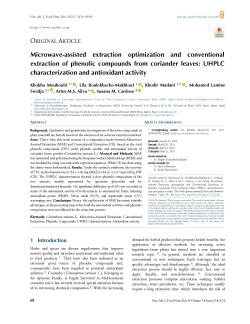Main Article Content
Microwave-assisted extraction optimization and conventional extraction of phenolic compounds from coriander leaves: UHPLC characterization and antioxidant activity
Abstract
Background: Qualitative and quantitative investigations of bioactive compounds in plant materials are heavily based on the selection of an accurate extraction method.Aims: That’s why; this work consists of a comparative study between Microwave Assisted Extraction (MAE) and Conventional Extraction (CE), based on the total phenolic compounds (TPC) yield, phenolic profile, and antioxidant activity of coriander leaves powder (Coriandrum sativum L.). Material andMethods: MAE was optimized and performed using the Response Surface Methodology (RSM), and was modeled by using a second-order regression equation. While CE was done using the classic water bath method. Results: Under the optimal conditions, the recovery of TPC yield obtained was 37.94 ± 2.06 mg (MAE) vs 44.47 ± 0.57 mg GAE/g DW (CE). The UHPLC characterization showed a close phenolic composition of the two extracts, mainly represented by quercetin glucosides and by dimethoxycinnamoyl hexoside. No significant difference (p>0.05) was recorded in terms of the antioxidant activity of both extracts, as estimated by Ferric reducing antioxidant power (FRAP), Nitric oxide (NO•), and superoxide anion (O2•-) scavenging tests. Conclusions: Hence, the exploitation of MAE has many valuable advantages, as the processing time is brief and the antioxidant activities and phenolic composition were not affected by the extraction process.







